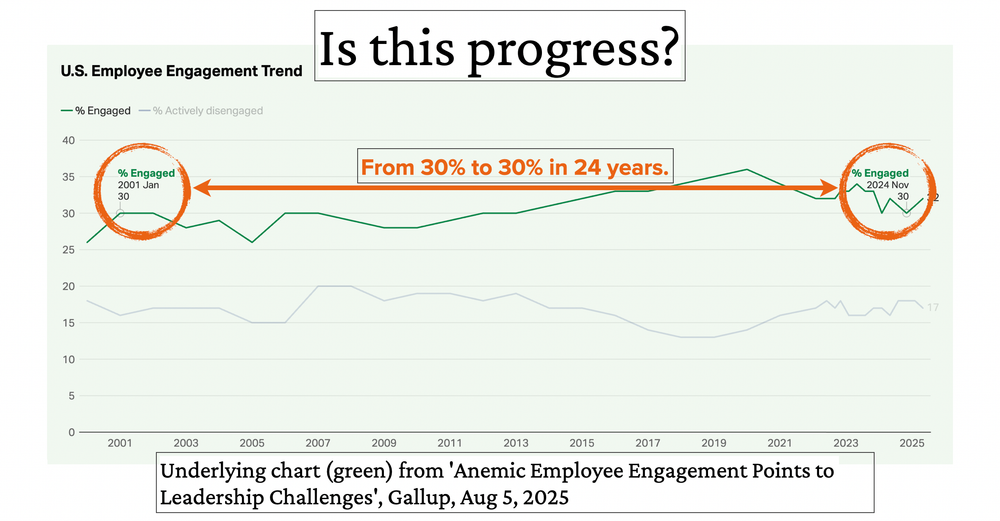How “engagement” became the most expensive leadership myth in corporate history
We’ve been told—repeatedly, reverentially—that employee engagement is the holy grail of leadership. Gallup built an empire on it. Consultants turned it into a global industry. CHROs built careers around nudging it a percentage point higher. And yet here we are, twenty-five years later, with engagement still stuck at 32%, down from its brief pandemic-era peak of 36%, and costing U.S. businesses a mind-numbing $2 trillion a year in lost productivity.
How is this possible? How can an idea so widely celebrated be so profoundly non-functional? Every year, we measure, we publish, we hold managers accountable for numbers that never move—and then act surprised when they don’t. It’s as if the entire corporate world is participating in a mass experiment to prove Einstein’s definition of insanity.
Maybe you’ve felt that quiet sense of disbelief yourself. You’ve sat through the PowerPoint deck, the one with the cheerful color-coded bar chart showing engagement inching from 31% to 32%, and someone in HR calls it “progress.” You look around the room and wonder, Progress toward what? Because nothing seems different. The culture still feels cautious. Teams still avoid real conversations. Turnover is still eating budgets. The only thing that changes is the consultant’s logo on the slide.
The truth is embarrassingly simple: engagement is a lag indicator, not a lead indicator. It’s the smoke, not the fire. It measures how people felt about their environment after the fact. That’s why the relationship between engagement and performance is forever fuzzy—thin correlations, hard-to-replicate causality, and lots of retroactive storytelling. We treat it like a steering wheel when it’s really a rear-view mirror. And you don’t win races staring into mirrors.
Since Gallup launched the Q12 in 1999, organizations have spent tens of billions on training, software and consulting designed to “boost engagement.” Yet according to Gallup’s own research (see chart), engagement in 2025 is the same as it was in 2001. Twenty-four years. Zero structural improvement. If this were any other metric—supply chain efficiency, product quality, profit margin—it would’ve been overhauled a decade ago. But engagement has become untouchable dogma, the leadership equivalent of bloodletting: everybody does it because everybody does it.
And here’s the cruel irony: Gallup’s own data tells us exactly why it fails. In their latest report, they point out that 70% of a team’s engagement depends on its direct manager. Yet roughly nine in ten leaders have never received meaningful training in how to lead. Most were promoted for technical skill, not for people capability. We hand them dashboards and demand cultural transformation, then act bewildered when nothing happens. It’s not their fault—it’s the system’s.
What leaders actually need isn’t another annual survey. They need a real-time operating rhythm that connects leader behaviours to team health and team productivity. That’s where Circular Leadership comes in.
Circular Leadership starts from a simple but radical idea: stop managing outcomes and start designing the conditions that make great outcomes inevitable. The model runs on a 90-day cycle: one week of planning, celebration, and learning, followed by twelve weeks of execution. It’s built around a wheel, not a line—because leadership isn’t a one-way street from “Goal” to “Accountability.” In the GITA model—Goal Clarity, Individual Support, Team Dynamics, Accountability—each element feeds the next.
- Goal Clarity: agree on what matters most this quarter. Make it vivid, measurable and connected to customer impact.
- Individual Support: build psychological safety first. People can’t perform if they can’t speak up, ask for help or admit uncertainty.
- Team Dynamics: set the norms that create respect, fairness and inclusion—the social glue that makes collaboration effortless.
- Accountability: not a quarterly beat-down, but the natural outcome of doing the first three right.
The Circular Leader app makes this tangible. Every 90 days, each team answers 25 questions on Team Health (psychological safety) and six on Performance Capacity. The app then generates a dozen charts—Team Health, Team Performance, Health + Performance, Turnover Risk and more—each with a short introduction and practical “how to support it” suggestions. Low score on Goal Clarity? There’s a fix. Weak Team Dynamics? Get real, behavioral suggestions. These are the things that actually move how team's feel AND perform.
Circular Leadership measures what matters before performance collapses. Psychological safety is the lead indicator engagement was trying to be. It predicts innovation, customer satisfaction, staff retention and team performance. When psychological safety rises, people contribute ideas earlier, own outcomes faster and recover from mistakes more intelligently. It’s measurable, actionable and verifiable with small datasets—exactly the conditions that make modern management work.
Run this system for a single quarter and you’ll see what twenty-five years of engagement surveys never delivered: visible improvement. Teams know what they’re aiming for. Conversations happen before things go wrong. Accountability feels fair, not fearful. And a manager (you!) finally has something better to do than wait for next year’s engagement results.
So yes, the engagement illusion cost us $2 trillion a year, but the bigger loss was opportunity—the decades we could have spent building workplaces that actually function. The good news is the fix is here, and it’s free. The Circular Leader app is available now. It doesn’t promise higher engagement. It promises something better: leaders who can see, act and support their teams in real time.
Because engagement doesn’t need another consultant. It needs a funeral. And leadership needs a resurrection.
Receive new posts straight to your inbox.
No spam ever. Unsubscribe anytime, no questions asked.

